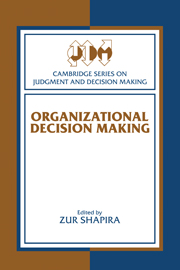Book contents
- Frontmatter
- Contents
- Series preface
- List of contributors
- Editor's preface
- Part I Introduction
- Part II Information processing and attention allocation
- 3 Trying to help S&Ls: How organizations with good intentions jointly enacted disaster
- 4 Organizational choice under ambiguity: Decision making in the chemical industry following Bhopal
- 5 Strategic agenda building in organizations
- Part III Preference processing
- Part IV Decision processes
- Part V Alternative approaches
- Name index
- Subject index
3 - Trying to help S&Ls: How organizations with good intentions jointly enacted disaster
Published online by Cambridge University Press: 06 August 2010
- Frontmatter
- Contents
- Series preface
- List of contributors
- Editor's preface
- Part I Introduction
- Part II Information processing and attention allocation
- 3 Trying to help S&Ls: How organizations with good intentions jointly enacted disaster
- 4 Organizational choice under ambiguity: Decision making in the chemical industry following Bhopal
- 5 Strategic agenda building in organizations
- Part III Preference processing
- Part IV Decision processes
- Part V Alternative approaches
- Name index
- Subject index
Summary
Failures of U.S. savings and loan institutions (S&Ls) in the 1980s added up to one of the largest financial disasters ever to hit the nation. The costs fell on everyone because the Federal Savings and Loan Insurance Corporation (FSLIC) insured the deposits. In 1990, the General Accounting Office estimated that the insurance losses would ultimately exceed $325 billion – over $1,000 for each resident of the United States (Barth, 1991).
Since many books and articles have appeared about this disaster, a reader might wonder what else there is to say. Improbably, this chapter argues that several explanations do not work and that analysts have slighted some important factors. Analysts have ignored or deemphasized the effects of decision processes and nearsighted analyses. Most analysts have also focused on events during the 1980s and understated the importance of longterm trends and abrupt policy changes.
The decision processes involved many organizations. Most of these were loosely coupled in that their actions only sporadically affected others, and they often acted without considering the likely impacts on others. Many organizations were also tightly coupled in that broad agreement and shared perceptions shaped most actions, and one organization's acts could sometimes profoundly affect another's future.
Because the disaster had many possible causes and involved many actors, understanding it requires a grasp of numerous details. The first section of this chapter recounts the history of the S&L industry, setting a context for events in the 1980s.
- Type
- Chapter
- Information
- Organizational Decision Making , pp. 35 - 60Publisher: Cambridge University PressPrint publication year: 1996
- 2
- Cited by



